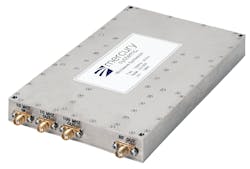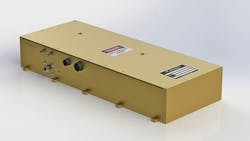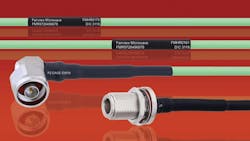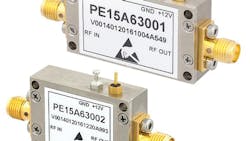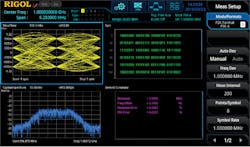RF and microwave equipment: tackling the interference problem
In the air, sea, or on the battlefield, RF and microwave technology is providing incredible amounts of information for command and control in addition to the “boots on the ground.” Wireless communications through RF signals provides the clear, interpretable intelligence to those who need it most.
The presence of dense RF signal traffic on the battlefield today is constant; radio silence is no longer the norm. Today’s military needs not only to deny capabilities of their adversaries, but also keep its own systems online at the same time.
The need to maintain contact radio communications on the modern battlefield elevates the need to fight intentional and accidental RF interference a necessity. Mitigating the effects of RF interference (RFI), electromagnetic interference (EMI), and electromagnetic compatibility (EMC) are just as important as battling opposing forces and achieving combat readiness.
RF and microwave technology experts in the industry must consider how to tackle co-site interference, jamming and countermeasures, and other factors, explains Rodger Hosking, vice president of Pentek Inc. in Upper Saddle River, N.J.
“This classic problem has been a challenge for mil-aero equipment from the beginning from three major sources,” says Hosking. Co-site interference refers to the effect of multiple radars and radios operating on the same aircraft, ship, or vehicle. Jamming or countermeasures by the enemy intentionally disrupt reception of equipment to deny or reduce operational performance.
“Situational factors of the spectral landscape for a given location often present strong signals from commercial broadcast and telecom services that can interfere with radio and radar systems, and these can change over time and as the platform changes position,” Hosking says.Crowded neighborhood
Military vehicles and communications systems are filled with electronic components that emit electrical interference, and need RF protection from outside interference. In addition, the more information transmitted means more the RF spectrum is in use, creating more issues that manufacturers need to address.
This creates a two-pronged problem: how to keep the electronic components from interfering with one another while protecting them from outside interference, explains Dan Mor, general-purpose graphics processing unit (GPGPU) product manager at Aitech Systems Ltd. in Chatsworth, Calif.
“Emissions from the operational system itself on external equipment, which can be mission-critical, also can disturb the proper operation of peripheral systems,” Mor told Military & Aerospace Electronics last year.
“The system should be immune from external noise and not produce noise to the outside word,” Mor continued. “These are two main reasons why EMI/EMC is so important. Almost every new project we have — in avionics, ground fixed, ground mobile vehicles, etc. — requires EMI mitigation or EMC. Sometimes we need to prove that our products are designed and manufactured to meet these requirements and specifications.”
Avoiding interference
With the growing use of electronic systems onboard ships, aircraft, and on the ground, available space on the RF band is becoming difficult to come by.
“With increasing utilization of the already-crowded radio frequency spectrum and the increasing number of services and devices competing for its use, these interference problems are becoming more critical,” Pentek’s Hosking points out. “A very popular strategy to mitigate these problems is the use of phased-array antennas consisting of multiple elements.
“By precisely controlling the relative phase shift among the elements, these beamforming antennas can electronically steer the antenna beam pattern,” Hosking explains. “This works equally well for both receive and transmit functions and operates for both elevation and azimuth angles. By doing so, the effect of an interfering signal arriving from one direction can be greatly reduced, while enhancing a desired signal receptivity from another direction.”RIGOL Technologies Inc. of Beaverton, Ore., recently released the newest member of its UltraReal family of real-time spectrum analyzers. The company aims to help RF engineers characterize most of today’s complex RF modulation schemes, including quadrature amplitude modulation (QAM), quadrature phase shift keying (QPSK), amplitude-shift keying (ASK), minimum-shift keying (MSK), and frequency shift keying (FSK).
RIGOL’s RSA5000 vector signal analyzer (VSA) enables engineers to use as many as 13 integrated measurement functions including I/Q waveform and RF envelope, constellation and vector diagrams, symbol level decode, time and frequency, and bit error analysis against known sequences by providing quick insight into signal behaviors.
“Engineers integrating these technologies need affordable, powerful and easy-to-use tools to quickly characterize their transceivers and identify communication errors,” says Michael Rizzo, general manager of RIGOL North America. “We are pleased that the RSA5000 Spectrum Analyzer and the new VSA Measurement application can support this emerging need.”
Officials of Micro Lambda Wireless Inc. of Fremont, Calif., say they are increasing production of their company’s benchtop frequency synthesizers.
Alongside their yttrium iron garnet (YIG) RF and synthesizer components, their custom-tuned benchtop YIG synthesizer line now offers RF and microwave designers working at frequencies to 20 GHz the chance to upgrade their test benches.
The YIG synthesizers offer bandwidth as wide as -125 dBc/Hz at 10 kHz offset phase noise at a carrier frequency of 10 GHz. These frequency synthesizers produce low phase noise performance, and can tuning speeds up to 50 microseconds over wide bands, and offer output power levels of +15 dBm, with power leveling in frequency bands up to 10 GHz.
These synthesizers consist of a frequency synthesizer, AC power supply, heat sink with fan, keypad, tuning knob, frequency display. and driver circuitry all housed in a compact, durable bench top box measuring 4 by 10 by 13 inches. Units are tunable manually over the specified frequency range by a designer’s choice of the mechanical knob, keypad, or via USB or Ethernet connection.The best offense ...
On the power electronics side, dB Control Corp. in Fremont, Calif., has introduced a compact, lightweight, pulsed microwave power module (MPM) that operates in the 6-to-18-GHz frequency range and provides 1 kilowatt peak power at 5 percent maximum duty cycle. The dB-3774B weighs 18 pounds and dimensions are 7 by 3 by 18 inches.
The dB3774B is suitable for electronic warfare (EW) applications like radar jamming, and features a conduction-cooled mini traveling wave tube (TWT) for power amplification and a solid-state driver amplifier for RF gain.
The high-voltage power supply section of the dB-3774B uses modular architecture and low-noise power supply topology. Additionally, the conduction-cooled dB-3774B MPM operates with 270-volt DC prime power, resulting in high efficiency in DC operation, and custom frequency bands are available.
... is a good defense
A great way sow chaos and confusion among military adversaries is to deny the use of expensive pieces of technology. Likewise, it is imperative to keep allied systems online to maintain an advantage.
Last month, Mercury Systems of Andover, Mass., unveiled its DS-3000 synthesizer, which is part of its SpectrumSeries line, and is a direct digital synthesis (DDS)-based synthesizer, as a way monitor wide bands to mitigate hazards.
“Today’s announcement reinforces Mercury’s ongoing commitment to commercializing innovative RF solutions that provide the U.S. warfighter and our allies the technical edge they need to meet their mission requirements,” says Neal Austin, vice president and general manager of Mercury’s Embedded Sensor Processing group on June 4.
“In an environment of rapidly emerging electronic threats, customers can count on our industry-leading synthesizer technology to provide the expanded performance and reliability needed by modern EW and ELINT systems so they can monitor wide bands of the electromagnetic spectrum in order to detect, analyze, and mitigate new threats.”
The DS-3000 synthesizer offers phase noise of -121 dBc/Hz at 10 GHz with 10 kHz offset, and frequency coverage up to 20 GHz with 1 Hz resolution and is suitable for EW and electronic intelligence (ELINT) systems that monitor large radio frequency (RF) bandwidths through either a channelized architecture or wide instantaneous bandwidth (IBW).
Mercury’s DS-3000 offers performance over a temperature range of -30 to 70 degrees Celsius, while minimizing the effects of microphonics. Additionally, users can control the hardware through either a PC-based graphical user interface (GUI) or an SPI-bus makes these products suited for benchtop operation and integration into ruggedized EW systems.Cages and cables
One way RF engineers protect systems is by putting vulnerable components inside a ruggedized enclosure, particularly those of commercial off-the-shelf (COTS), which aren’t purpose built to minimize electrical interference. A relatively inexpensive safeguard is to house components inside an enclosure with a Faraday cage lining which blocks RFI, though higher-tech solutions have been implemented.
However, even if the components inside the chassis are shielded from interference and are not emitting interference, engineers also must consider the cables running outside of the enclosure.
This spring, Fairview Microwave Inc. in Lewisville, Texas, introduced a series of high-reliability, temperature-conditioned RF cable assemblies for military electronics, avionics, satellite communications, identification-friend-or-foe, and EW and similar mission-critical applications.
The low-loss, pre-conditioned, high-reliability cables cover operating frequencies to 18 GHz and deliver a voltage standing wave ratio (VSWR) as low as 1.35:1.
This product line has 128 configurations built from three different types of cable, totaling more than 1,400 parts.
Pasternack Enterprises in Irvine, Calif., has launched a line of low-PIM coaxial cable assemblies that are suitable for distributed antenna systems (DAS) and are available in standard and custom lengths.
The cable assemblies consist of 18 standard configurations with PIM levels of less than -160 dBc. This product line is made with lightweight, flexible UL910 plenum-rated SPP-250-LLPL RF coaxial cable which can operate in temperatures from -55 to 125 C.
They are offered with the following connector types: 4.3-10, 7/16 DIN, 4.1/9.5 mini-DIN and Type-N, which also include right-angle connector options. In addition to distributed antennas, these cables are for indoor wireless systems, wireless infrastructure, multi-carrier communication systems, WISP networks, small cell installations and PIM testing applications.
“The launch of this product line not only gives us the opportunity to provide our customers with high-quality, low-PIM cable assemblies, but now we’re also able to deliver them in standard and custom lengths with same-day delivery. The combination of the cables’ features and in-stock availability makes this product launch a truly unique and exciting addition for our customers to take advantage of,” says Pasternack Product Manager Steve Ellis.
Multi-faceted
Pentek’s expertise in software-defined radio positions the company to minimize interference with products such as multi-channel data converters for receiving and transmitting signals, as well precise control of the phase shifts for antenna arrays, Hosking says.
Field-programmable gate arrays (FPGAs) are big contributors to this capability. “By combining both receive and transmit capabilities with advanced FPGA technology, Pentek products also support adaptive radio algorithms that can respond quickly to changing environments and countermeasures,” Hosking says. “All of Pentek’s latest products offer optical interfaces to minimize pickup of interference and maintain full dynamic range of RF and microwave signals.”
When asked if there was a product Pentek offered that best showcased approach to minimizing interference in mil-aero applications, Hosking selected the Model 6001 QuartzXM Express Module.
“(It) is a highly integrated module that harnesses Xilinx’s Zynq RFSoC (RF System-on-Chip). It includes eight multi-gigahertz sample rate A/D and D/A converters, UltraScale+ FPGA fabric, a multi-core ARM processor and dual 100 Gigabit Ethernet interfaces with available optical interfaces,” Hosking says. “Single-handedly, the 6001 tackles all of the interference mitigation strategies (I) outlined. Only 2.5 by four inches in size, it can be easily integrated into highly SWaP-constrained equipment for applications such as unmanned vehicles, airborne pods, missiles, vehicles, and portable systems.”
RF and microwave interference could mean the difference between mission success or failure and life or death, Hosking points out.
“The effect of RF and microwave interference ranges from a slight degradation of equipment performance to complete denial of operation. In a mil-aero platform, this can mean a loss of life, tactical advantage, equipment, platforms, and critical intelligence,” Hosking says.
company list
Aitech
Chatsworth, Calif.
www.rugged.com
Crystal Group
Hiawatha, Iowa
www.crystalrugged.com
Curtiss-Wright Defense Solutions
Ashburn, Va.
https://www.curtisswrightds.com
dB Control
Fremont, Calif.
www.dbcontrol.com
Elma Electronic
Fremont, Calif.
www.elma.com
Fairview Microwave Inc.
Lewisville, Texas
www.fairviewmicrowave.com
Mercury Systems
Andover, Mass.
www.mrcy.com
Micro Lambda Wireless
Fremont, Calif.
https://www.microlambdawireless.com
Pasternack Enterprises
Irvine, Calif.
www.pasternack.com
Pentek Inc.
Upper Saddle River, N.J.
www.pentek.com
RIGOL
Beaverton, Ore.
www.rigolna.com
VPT
Blacksburg, Va.
www.vptpower.com
W.L. Gore
Newark, Del
www.gore.com
About the Author
Jamie Whitney
Senior Editor
Jamie Whitney joined the staff of Military & Aerospace Electronics in 2018 and oversees editorial content and produces news and features for Military & Aerospace Electronics, attends industry events, produces Webcasts, and oversees print production of Military & Aerospace Electronics.
